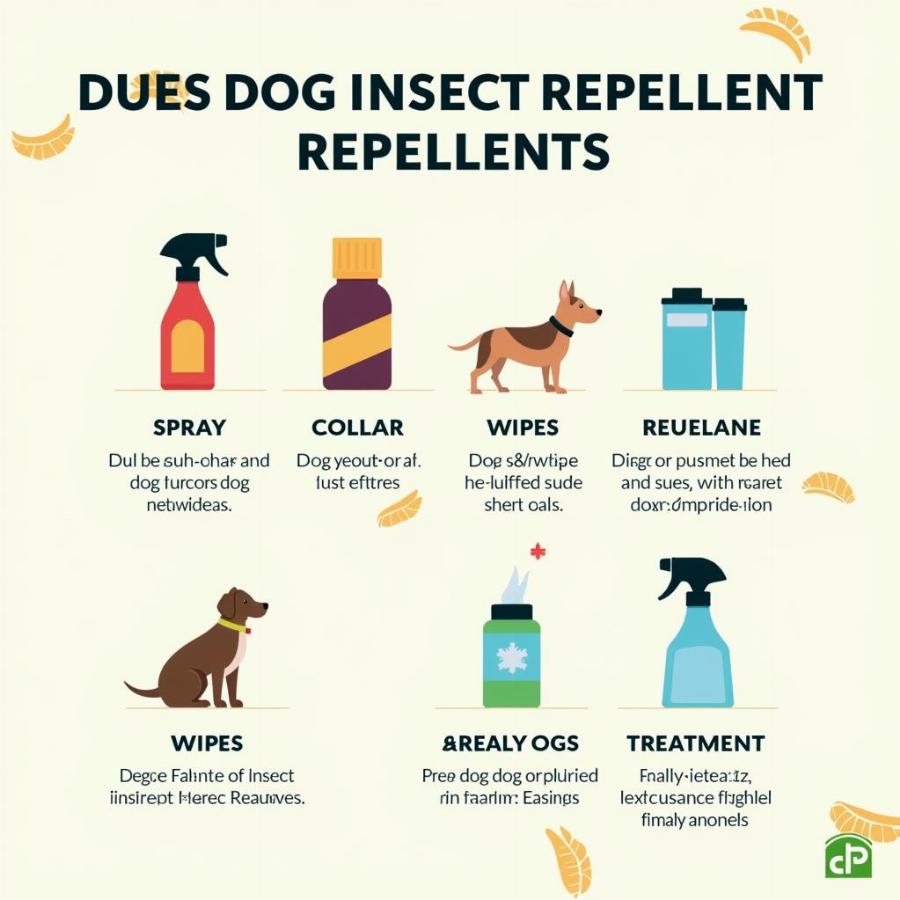Protecting your dog from biting insects is a crucial part of responsible pet ownership. Dog insect repellent plays a vital role in preventing discomfort, disease transmission, and potential allergic reactions. This comprehensive guide will explore various types of repellents, discuss their effectiveness, and provide practical tips for keeping your canine companion safe from pests.
Choosing the Right Dog Insect Repellent
When selecting a dog insect repellent, consider your dog’s age, size, breed, and overall health. There are several types of repellents available, each with its own pros and cons. Always consult with your veterinarian before using any new product, especially on puppies or senior dogs.
Natural Repellents
Natural repellents often derive from essential oils like citronella, lemongrass, and eucalyptus. These can be effective against certain insects but might not be as potent as chemical options. Some dogs are also sensitive to essential oils, so always start with a small test area and monitor for any adverse reactions.
Chemical Repellents
Chemical repellents typically contain DEET, permethrin, or pyrethrin. DEET is generally safe for dogs when used as directed, but avoid applying it to broken skin or near the eyes and mouth. Permethrin, on the other hand, is highly toxic to cats and should never be used on or around them. Pyrethrin is less toxic but can still cause adverse reactions in some pets.
 Different Types of Dog Insect Repellents
Different Types of Dog Insect Repellents
Homemade Repellents
Many pet owners prefer homemade dog insect repellent options using ingredients like apple cider vinegar and specific essential oils. While these can be cost-effective, their efficacy can vary, and it’s essential to research safe and appropriate recipes. Check out our guide on homemade bug repellent for dogs for more detailed information.
Application and Safety Tips for Dog Insect Repellent
Applying dog insect repellent correctly is essential for its effectiveness and your dog’s safety. Always follow the product’s instructions carefully. Avoid applying repellent to broken skin, near the eyes, nose, or mouth. Wash your hands thoroughly after application.
How often should I apply dog insect repellent?
The frequency of application depends on the specific product and the level of insect activity in your area. Some repellents provide protection for several hours, while others require more frequent application.
What should I do if my dog ingests insect repellent?
If your dog ingests insect repellent, contact your veterinarian or the ASPCA Animal Poison Control Center immediately.
Preventing Insect Bites Beyond Repellent
While dog insect repellent is a valuable tool, incorporating other preventative measures can further protect your furry friend.
Maintaining a Clean Environment
Regularly cleaning your yard and removing standing water can significantly reduce mosquito breeding grounds. Keep your dog’s bedding clean and check for ticks after walks, especially in wooded or grassy areas. You can find more helpful tips on our page about tick killer for yard safe for dogs. Consider investing in a well-maintained best little dog house in texas to provide your dog with a safe and comfortable outdoor space.
Protective Clothing
Consider using protective clothing for your dog, such as lightweight vests or shirts, especially during peak insect season. This can provide an additional barrier against bites.
Checking for Ticks
Regularly check your dog for ticks, especially after spending time outdoors. Knowing what to look for is crucial. Check out our resource on dog ticks pictures to familiarize yourself with tick identification.
What if my dog gets bitten despite using repellent?
Even with the best precautions, insect bites can still occur. Monitor your dog for any signs of allergic reactions, such as swelling, redness, or excessive itching. If you notice any concerning symptoms, contact your veterinarian immediately.
Conclusion
Protecting your dog from insects requires a multi-faceted approach. Dog insect repellent, when used correctly and in conjunction with other preventative measures, can effectively minimize the risk of bites and potential health issues. Remember to choose a repellent that suits your dog’s individual needs and always consult with your veterinarian if you have any concerns.
FAQ
- Can I use human insect repellent on my dog? No, human insect repellents often contain ingredients that are toxic to dogs.
- What are the signs of an allergic reaction to an insect bite? Swelling, redness, excessive itching, hives, and difficulty breathing are potential signs.
- How can I make my yard less attractive to insects? Eliminate standing water, keep grass trimmed, and consider using pet-safe insecticides.
- What should I do if I find a tick on my dog? Carefully remove the tick using tweezers, ensuring you remove the entire head.
- Are there any breeds more susceptible to insect bites? Yes, some breeds with thinner coats or skin folds may be more prone to bites.
- Can insect bites transmit diseases to dogs? Yes, insects can transmit diseases like Lyme disease, heartworm, and ehrlichiosis.
- How can I protect my dog from mosquitoes while camping? Use a dog-safe mosquito repellent, consider a mosquito net for their sleeping area, and keep them indoors during peak mosquito hours.
Further Reading
Explore these related articles on Beaut Dogs for more information on dog care and well-being: Effective fence ideas for dogs.
Beaut Dogs: Your Trusted Source for Dog Care
Beaut Dogs is your one-stop resource for all things canine. We provide expert advice and guidance on everything from breed selection to health care, nutrition, and training. When you need support, reach out to us at Email: [email protected], and Beaut Dogs will provide detailed and accurate answers. Visit https://beautdogs.com today to learn more!